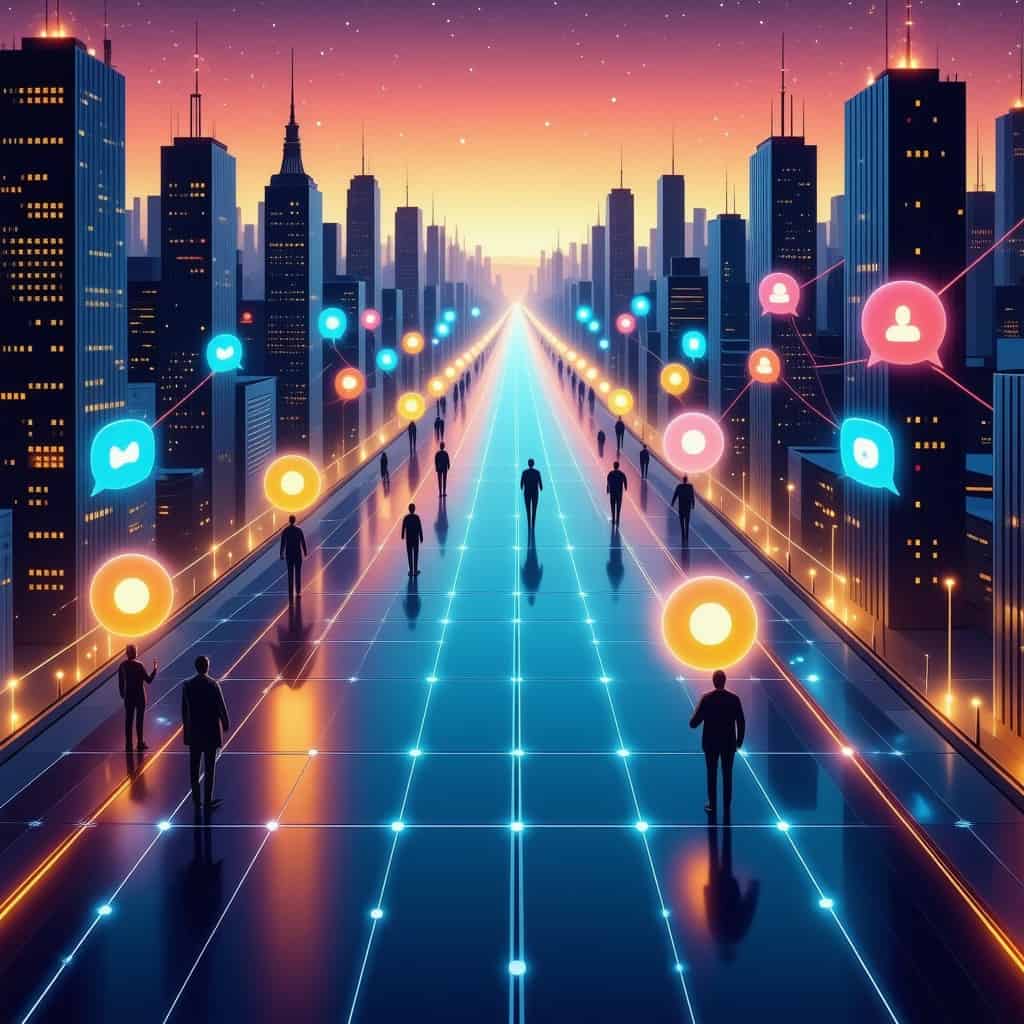In today’s digital landscape, chatbots have become indispensable tools for businesses seeking to enhance customer engagement and streamline operations. As we delve into the world of chatbot features, we’ll uncover the core functions and capabilities that make these AI-powered assistants invaluable assets. From understanding the fundamental components of chatbot functionality to exploring advanced chat bot features, this comprehensive guide will illuminate the essential elements that drive effective bot chats. Whether you’re a business owner looking to leverage chatbots for customer service or a tech enthusiast curious about the latest innovations in AI-driven communication, join us as we unveil the key chatbot capabilities shaping the future of digital interactions.
Understanding Chatbot Features
Chatbot features are the core functionalities and capabilities that enable AI-powered conversational interfaces to interact with users effectively. These features form the backbone of chatbots, allowing them to understand, process, and respond to user inputs in a human-like manner. At Messenger Bot, we’ve harnessed these capabilities to create a powerful automation platform that enhances digital communication across various channels.
The evolution of chatbot technology has led to increasingly sophisticated features, ranging from basic rule-based responses to advanced natural language processing and machine learning algorithms. These advancements have made chatbots invaluable tools for businesses seeking to improve customer engagement, streamline operations, and provide round-the-clock support.
What is a chatbot feature?
A chatbot feature is a specific functionality or capability that enables the bot to perform certain tasks or interact with users in a particular way. These features can include:
- Natural Language Processing (NLP) for understanding user intent
- Automated responses based on predefined rules or AI-driven analysis
- Multi-language support for global communication
- Integration with various platforms and databases
- Personalization capabilities to tailor interactions
For instance, our Messenger Bot platform incorporates advanced features like AI-driven automated responses and multilingual support, enabling businesses to engage with their audience effectively across different languages and cultures.
Core components of chatbot functionality
The core components that make up chatbot functionality are essential for creating a robust and effective conversational AI system. These components work together to deliver a seamless user experience:
- Input Processing: This component handles the initial user input, whether it’s text, voice, or even images.
- Intent Recognition: Using NLP, the chatbot identifies the user’s intention behind the input.
- Dialog Management: This system manages the flow of conversation, ensuring coherent and contextual interactions.
- Response Generation: Based on the recognized intent and conversation context, the chatbot generates an appropriate response.
- Output Delivery: The final step where the response is delivered to the user in the chosen format (text, voice, or visual).
At Messenger Bot, we’ve refined these core components to create a powerful AI-driven platform that can handle complex interactions across various channels, including social media platforms and websites. Our chatbot features are designed to provide businesses with the tools they need to automate and optimize their customer communications effectively.

Essential Functions of Chatbots
Chatbots have become integral to modern business operations, offering a wide array of chatbot features that streamline customer interactions and enhance user experience. As we delve into the core functions of chatbots, it’s crucial to understand how these AI-powered tools are revolutionizing digital communication.
What are the core functions of a chatbot?
The primary functions of chatbots encompass several key areas:
- Automated Customer Support: Chatbots provide instant responses to common queries, reducing wait times and improving customer satisfaction.
- Lead Generation: By engaging visitors and collecting information, chatbots can qualify leads and nurture potential customers through the sales funnel.
- Personalized Recommendations: Advanced chatbots analyze user preferences to offer tailored product or content suggestions.
- Data Collection and Analysis: Chatbots gather valuable insights from user interactions, helping businesses refine their strategies.
- 24/7 Availability: Unlike human agents, chatbots can operate round the clock, ensuring constant customer engagement.
These core functions form the backbone of chatbot capabilities, enabling businesses to enhance their customer service and operational efficiency significantly.
Chatbot features and benefits for businesses
The features of chatbots offer numerous benefits that can transform how businesses interact with their customers. Here are some key advantages:
- Cost Reduction: By automating routine tasks, chatbots help businesses cut operational costs associated with customer service.
- Improved Efficiency: AI-driven chatbot optimization allows for faster response times and more efficient handling of customer inquiries.
- Scalability: Chatbots can handle multiple conversations simultaneously, allowing businesses to scale their customer support without proportionally increasing staff.
- Enhanced Customer Experience: With features like natural language processing, chatbots can provide more human-like interactions, improving overall customer satisfaction.
- Data-Driven Insights: The analytical capabilities of chatbots provide valuable customer data that can inform business decisions and marketing strategies.
At Messenger Bot, we’ve witnessed firsthand how our AI-powered chatbot solutions have transformed customer interactions for businesses across various industries. Our platform’s advanced features, including multilingual support and seamless integration with popular messaging platforms, enable businesses to create engaging bot chats that drive results.
While there are several chatbot providers in the market, such as Zendesk and Intercom, we pride ourselves on offering a unique combination of user-friendly interfaces and sophisticated AI capabilities. This allows businesses of all sizes to leverage the power of chatbot features effectively.
As the demand for efficient customer communication continues to grow, the role of chatbots in business operations is becoming increasingly crucial. By harnessing the full potential of chatbot capabilities, companies can stay ahead in the competitive digital landscape while providing exceptional service to their customers.
III. Common Elements Across AI Chatbots
As we delve into the world of AI chatbots, it’s crucial to understand the common elements that tie these digital assistants together. At Messenger Bot, we’ve observed that while each chatbot may have unique features, there are fundamental components that form the backbone of most AI-powered chat interfaces.
A. What is a common feature among different AI chatbots?
One of the most prevalent features across various AI chatbots is natural language processing (NLP). This technology enables bots to understand and interpret human language, allowing for more fluid and context-aware conversations. NLP is the cornerstone that allows chatbots to provide relevant responses and maintain coherent dialogues.
Another common element is the ability to handle multiple queries simultaneously. Whether it’s a customer service bot or a virtual assistant, modern chatbot features include the capacity to engage with numerous users at once, significantly enhancing efficiency and response times.
Personalization is also a key feature shared by many AI chatbots. By leveraging user data and interaction history, these bots can tailor their responses and recommendations to individual preferences, creating a more engaging and personalized user experience.
B. Comparing features of ChatGPT and other AI chatbots
When comparing ChatGPT to other AI chatbots, several distinguishing factors come to light. ChatGPT, developed by OpenAI, stands out for its advanced language model that can generate human-like text based on the input it receives. However, it’s important to note that while ChatGPT excels in open-ended conversations, many business-oriented chatbots, including our own Messenger Bot, are designed with specific use cases in mind, offering more focused and actionable responses.
For instance, customer service chatbots often include features like ticket creation and routing, which ChatGPT doesn’t offer out of the box. These bot chat capabilities are crucial for businesses looking to streamline their support processes.
Integration capabilities also differ significantly. While ChatGPT can be integrated into various platforms through APIs, many business chatbots, including solutions from companies like Zendesk, offer native integrations with CRM systems and other business tools, making them more suitable for enterprise environments.
Another key difference lies in customization. ChatGPT provides a general-purpose conversational AI, whereas many business chatbots allow for extensive customization of responses, workflows, and even the bot’s personality to align with brand voice and specific business needs.
In terms of multilingual support, while ChatGPT can communicate in multiple languages, specialized chatbots often offer more refined language processing tailored to specific industries or regions. Our Messenger Bot’s multilingual capabilities are designed to handle nuanced business communications across various languages seamlessly.
As AI technology continues to evolve, the line between general-purpose AI like ChatGPT and specialized chatbots is becoming increasingly blurred. However, the focus on specific business outcomes and integration with existing systems remains a strong differentiator for enterprise-grade chatbot solutions.
IV. Operational Aspects of Chatbots
As we delve deeper into the world of chatbot features, it’s crucial to understand the operational aspects that make these AI-powered assistants so effective. Chatbots have become an integral part of modern business operations, revolutionizing customer interactions and streamlining processes across various industries.
A. What does chatbot actually do?
At its core, a chatbot is designed to simulate human-like conversations through text or voice interactions. These AI-powered tools utilize natural language processing (NLP) and machine learning algorithms to understand user queries and provide appropriate responses. Here’s a breakdown of what chatbots actually do:
- Answer Customer Queries: One of the primary functions of chatbots is to provide instant responses to frequently asked questions. This capability significantly reduces the workload on human customer service representatives and ensures 24/7 support availability.
- Process Transactions: Advanced chatbots can handle transactions, from making reservations to processing payments, offering a seamless experience for users.
- Collect Customer Data: Through conversations, chatbots gather valuable insights about customer preferences and behaviors, which can be used to improve products and services.
- Personalize User Experience: By leveraging AI and machine learning, chatbots can offer personalized recommendations and tailored responses based on user history and preferences.
- Automate Repetitive Tasks: Chatbots excel at handling routine inquiries and processes, freeing up human resources for more complex tasks that require empathy and critical thinking.
At Messenger Bot, we’ve designed our chatbot features to encompass all these functionalities and more, ensuring that businesses can leverage the full potential of AI-driven communication.
B. Real-world applications of bot chat capabilities
The versatility of chatbots has led to their adoption across various sectors, demonstrating the wide-ranging applications of bot chat capabilities:
- E-commerce: Chatbots assist customers in finding products, tracking orders, and providing post-purchase support. For instance, Amazon uses chatbots to enhance its customer service experience, handling a vast array of inquiries efficiently.
- Healthcare: In the medical field, chatbots are used for appointment scheduling, symptom checking, and providing basic health information. Platforms like Ada Health utilize AI to offer preliminary health assessments.
- Banking and Finance: Financial institutions employ chatbots for account inquiries, transaction processing, and even financial advice. Bank of America’s virtual assistant, Erica, is a prime example of AI integration in banking services.
- Travel and Hospitality: Chatbots in this industry help with booking accommodations, providing travel information, and offering personalized recommendations. Booking.com uses chatbots to streamline the reservation process and answer traveler queries.
- Education: In the realm of learning, chatbots assist with course inquiries, study material recommendations, and even basic tutoring. Platforms like Duolingo incorporate chatbots to enhance language learning experiences.
At Messenger Bot, we’ve observed these real-world applications and incorporated chatbot features and benefits that cater to diverse industry needs. Our platform enables businesses to create customized chatbot experiences that align with their specific operational requirements and customer expectations.
The operational aspects of chatbots continue to evolve, with advancements in AI and machine learning pushing the boundaries of what these digital assistants can achieve. As we look to the future, the integration of more sophisticated chatbot capabilities promises to further transform the landscape of digital communication and customer service.

Advanced Chatbot Capabilities
As we continue to innovate in the realm of AI-driven communication, chatbot features are evolving rapidly, offering businesses unprecedented opportunities to enhance customer interactions. At Messenger Bot, we’re at the forefront of this revolution, constantly pushing the boundaries of what chatbots can achieve.
Exploring latest chatbot features
The latest advancements in chatbot technology have introduced a suite of sophisticated features that are transforming the landscape of digital communication. Natural Language Processing (NLP) has reached new heights, allowing chatbots to understand context and nuance in human language with remarkable accuracy. This enables more fluid and natural conversations, making interactions with bot chats increasingly indistinguishable from human interactions.
One of the most exciting developments is the integration of sentiment analysis. Modern chatbots can now detect the emotional tone of a user’s message and respond appropriately, adding a layer of empathy to digital interactions. This feature is particularly valuable for businesses looking to provide personalized customer support and build stronger relationships with their audience.
Another groundbreaking feature is the ability to handle multi-turn conversations. Unlike earlier chatbots that struggled with context retention, today’s advanced chat bots can maintain context over extended dialogues, allowing for more complex problem-solving and decision-making processes.
AI-powered enhancements in modern chat bots
AI is the driving force behind the most impressive chatbot capabilities. Machine learning algorithms enable chatbots to continuously improve their performance based on past interactions, becoming more efficient and accurate over time. This self-improving capability ensures that the chatbot’s responses remain relevant and up-to-date without constant manual updates.
Voice recognition and text-to-speech technologies have also been integrated into many modern chatbots, allowing for seamless voice-based interactions. This feature expands the accessibility of chatbots and opens up new use cases, particularly in hands-free environments.
Perhaps one of the most powerful AI-driven enhancements is predictive analytics. By analyzing user data and behavior patterns, chatbots can now anticipate user needs and proactively offer solutions or information before the user even asks. This predictive capability not only improves the user experience but also helps businesses stay one step ahead of customer demands.
At Messenger Bot, we’ve harnessed these AI-powered enhancements to create a platform that’s not just reactive but proactive in meeting business needs. Our AI chat bot can be set up in minutes, offering a range of advanced features that can significantly boost your customer engagement and support efforts.
While competitors like Zendesk offer robust chatbot solutions, our focus on AI-driven personalization and ease of integration sets us apart in the market. We’re committed to providing businesses with chatbot features that not only meet current needs but anticipate future trends in customer communication.
As we look to the future, the potential for AI in chatbot technology seems boundless. From augmented reality integrations to even more sophisticated predictive models, the next wave of chatbot features promises to revolutionize how businesses interact with their customers. By staying at the cutting edge of these developments, we at Messenger Bot ensure that our clients are always equipped with the most advanced chatbot capabilities available.
VI. Comprehensive Chatbot Features List
At Messenger Bot, we understand the importance of comprehensive chatbot features in delivering exceptional customer service and user engagement. Our platform offers a wide array of chatbot features designed to enhance your business’s communication strategy.
A. Essential features of chatbots for customer service
When it comes to customer service, certain chatbot features are indispensable. These include:
1. Natural Language Processing (NLP): Our chatbots leverage advanced NLP algorithms to understand and respond to user queries naturally, mimicking human-like conversations.
2. Multi-channel support: We enable seamless integration across various platforms, including websites, Facebook Messenger, and Instagram, ensuring consistent customer support across all touchpoints.
3. 24/7 availability: Our AI-powered chatbots provide round-the-clock assistance, addressing customer inquiries at any time, reducing wait times, and improving overall satisfaction.
4. Quick response times: Messenger Bot’s chatbots deliver instant responses, significantly reducing customer wait times and enhancing the overall support experience.
5. Seamless human handover: When complex issues arise, our chatbots can smoothly transfer conversations to human agents, ensuring a seamless customer experience.
6. Multilingual support: Our chatbots can communicate in multiple languages, breaking language barriers and enabling businesses to serve a global customer base effectively.
7. Personalization: By leveraging user data and interaction history, our chatbots provide personalized responses and recommendations, enhancing the customer experience.
B. Innovative chat bot features for user engagement
To drive user engagement, Messenger Bot incorporates several innovative features:
1. Interactive buttons and carousels: Our chatbots use visually appealing elements like buttons and carousels to present information and options, making interactions more engaging and user-friendly.
2. Rich media support: We enable chatbots to share images, videos, and GIFs, creating more dynamic and immersive conversations.
3. Proactive messaging: Our chatbots can initiate conversations based on user behavior or predefined triggers, enhancing engagement and providing timely assistance.
4. Sentiment analysis: By analyzing user sentiment in real-time, our chatbots can adjust their tone and responses accordingly, ensuring more empathetic interactions.
5. Gamification elements: We incorporate interactive quizzes, polls, and challenges within chatbot conversations to boost user engagement and make interactions more enjoyable.
6. Voice and speech recognition: Our chatbots support voice commands and can transcribe speech to text, offering a hands-free interaction option for users.
7. Integration with business systems: Messenger Bot seamlessly integrates with CRM systems, e-commerce platforms, and other business tools, enabling chatbots to access relevant data and provide more accurate and personalized responses.
These comprehensive chatbot features offered by Messenger Bot empower businesses to deliver exceptional customer service and drive meaningful user engagement. By leveraging these capabilities, companies can create more efficient, personalized, and satisfying interactions with their customers across various digital channels.
VII. Maximizing Chatbot Potential
At Messenger Bot, we understand the importance of leveraging advanced chatbot features to drive business growth. Our AI-powered platform is designed to help businesses maximize their chatbot potential and stay ahead of future trends in bot chats and AI-driven communication.
A. Leveraging advanced chatbot features for business growth
To truly harness the power of chatbots, businesses need to utilize advanced features that go beyond basic conversational capabilities. Here are some key ways to leverage advanced chatbot features for business growth:
1. Personalization: Implement AI-driven personalization to tailor interactions based on user preferences, behavior, and history. This can significantly enhance customer engagement and satisfaction.
2. Omnichannel integration: Ensure your chatbot can seamlessly operate across multiple platforms, including websites, social media, and messaging apps. This provides a consistent user experience and expands your reach.
3. Natural Language Processing (NLP): Utilize advanced NLP capabilities to understand and respond to complex queries more accurately, improving the overall quality of interactions.
4. Sentiment analysis: Incorporate sentiment analysis to gauge customer emotions during conversations, allowing for more empathetic and appropriate responses.
5. Proactive engagement: Use chatbots to initiate conversations based on user behavior or predefined triggers, potentially increasing conversion rates and customer satisfaction.
6. Analytics and reporting: Leverage built-in analytics tools to gain insights into customer interactions, preferences, and pain points, enabling data-driven decision-making for business growth.
7. Integration with business systems: Connect your chatbot with CRM, e-commerce, and other business systems to provide more comprehensive and efficient service.
By implementing these advanced features, businesses can create more engaging, efficient, and effective chatbot experiences that drive growth and customer satisfaction.
B. Future trends in bot chats and AI-driven communication
As AI technology continues to evolve, the future of bot chats and AI-driven communication looks promising. Here are some emerging trends that we at Messenger Bot are keeping a close eye on:
1. Voice-enabled chatbots: With the rising popularity of voice assistants, chatbots are likely to incorporate more voice recognition and synthesis capabilities, enabling more natural and accessible interactions.
2. Emotional intelligence: Future chatbots will become more adept at recognizing and responding to human emotions, leading to more empathetic and personalized conversations.
3. Augmented Reality (AR) integration: Chatbots may soon incorporate AR features, allowing for more interactive and immersive customer experiences, especially in e-commerce and customer support scenarios.
4. Blockchain for enhanced security: As privacy concerns grow, blockchain technology may be integrated into chatbot systems to ensure secure and transparent data handling.
5. Multilingual capabilities: Advanced multilingual chatbots will become more prevalent, breaking down language barriers and enabling businesses to reach global audiences more effectively.
6. Predictive analytics: AI-powered chatbots will increasingly use predictive analytics to anticipate customer needs and offer proactive solutions.
7. Seamless human handoff: Future chatbots will be better at recognizing when to transfer complex queries to human agents, ensuring a smooth transition and maintaining context.
8. Continuous learning: Chatbots will employ more sophisticated machine learning algorithms to continuously improve their performance based on interactions and feedback.
As these trends evolve, it’s crucial for businesses to stay informed and adapt their chatbot strategies accordingly. At Messenger Bot, we’re committed to staying at the forefront of these developments, ensuring our platform remains cutting-edge and effective for our clients.
By embracing these future trends and leveraging advanced chatbot features, businesses can position themselves for success in an increasingly AI-driven communication landscape. The potential for growth and improved customer experiences through intelligent chatbot implementation is immense, and we’re excited to be part of this evolving journey.




